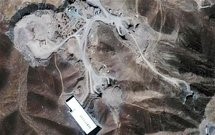 Barely hours after reports of North Korea conducting its third nuclear test, the Iranian Foreign Ministry spokesperson, Ramin Mehmanparast, reportedly called upon the world powers to abolish nuclear weapons. He stated, “We need to come to the point where no country has any nuclear weapons and at the same time all weapons of mass destruction and nuclear arms need to be destroyed”.
Barely hours after reports of North Korea conducting its third nuclear test, the Iranian Foreign Ministry spokesperson, Ramin Mehmanparast, reportedly called upon the world powers to abolish nuclear weapons. He stated, “We need to come to the point where no country has any nuclear weapons and at the same time all weapons of mass destruction and nuclear arms need to be destroyed”.
Understanding Iran’s Strategy
Not surprisingly, the statement comes with a caveat: “countries should still have the right to develop nuclear programs for peaceable uses,” clearly an articulation of Iran’s position on its controversial nuclear programme. The statement by Iran’s Foreign Minister can also be viewed against the backdrop of its ongoing negotiations with the International Atomic Energy Agency (IAEA); and possibly, also setting the tone and tenor for the next round of diplomatic talks with the delegates of US , Russia , UK , France , China and Germany (P5+1), in Kazakhstan later this month.
The ongoing Iran-IAEA talk in Tehran is aimed to “finalise the structured approach” and “facilitate the resolution of the outstanding issues related to the possible military dimension of Iran’s nuclear programme.” IAEA wants Iran to let it access its military base near Parchin, which the Agency had earlier inspected twice (last in 2005). Based on satellite imagery inputs, it is now suspected that Iran could have carried out experiments there, with explosives capable of triggering a nuclear weapon. However, Tehran has indicated that a possible opening up of the Parchin military site for inspections will be conditional upon the Agency recognising Iran’s “right to peaceful uses of nuclear energy”.
In yet another effort to speed up its enrichment activity, Tehran is planning to install and operate an advanced version of uranium enrichment IR2-m centrifuges at its facility at Natanz. These next generation centrifuges, Tehran claims, are specifically meant for low grade uranium enrichment below 5 per cent purity. Tehran has been articulating for long now that it needs to have complete control over its nuclear fuel cycle including the production of nuclear fuel in order to reduce its dependence on foreign sources. Since Iran is a signatory to the Nuclear Non Proliferation Treaty (NPT), it therefore has a right to use nuclear energy for peaceful purposes, under IAEA verification protocols. However, Tehran’s history of denials about its nuclear programme, coupled with a clear pattern of concealing nuclear –related information from the IAEA, has made the world suspicious that it is masking the development of nuclear weapons under the guise of a peaceful programme. The question is, what is the way forward?
Iran: A New Agenda for the International Community
Given the record of Iran’s past denials about its nuclear programme and concealing of information, the international community is justified in questioning Iran’s motives and demanding complete transparency. Clearly, Iran has failed to comply with the safeguards obligations which are the only means of determining the country’s compliance of its NPT obligations. Over the last decade, these failures have ranged from unreported imports of uranium compounds, failure to provide prior design information of its nuclear facilities to the IAEA, unreported import of centrifuges and so on. However, the IAEA inspections thus far indicate that Iran is short of acquiring a technical capability to produce ‘weapons.’ Tehran should now show full transparency and come clean on what it claims to be a nuclear programme for ‘peaceful purposes.’
Second , it should not make ‘ inspections’ a bargaining tool to further easing out sanctions which have been slapped earlier by the UN Security Council after Tehran’s refusal to stop uranium enrichment. The United States and the European Union have also imposed their own additional sanctions.
Third, the P5+1 and the rest of the international community , needs to recognise that a nuclear ‘stand- off’ has a potential of escalating, which could be detrimental for peace and security , particularly of West Asia. Threats of military solutions could even possibly force Iran to retreat from the NPT. The recent nuclear tests by North Korea is a clear example of the failure of international community to engage North Korea in a dialogue to contain its nuclear efforts. In such a scenario, the P5+1 should think of working towards a negotiated settlement and try to engage Tehran through a strategy of ‘inducements.’
Fourth, it may be prudent if Washington engages Tehran directly in a political dialogue to clear off the nuclear stalemate between the two. The terms of engagement for the aforementioned dialogue could be as follows: (a) maximum transparency by Iran to international inspectors , (b) IAEA to ascertain that Iran’s nuclear programme has no evidence of ‘weaponisation’, possibly , Iran could even transfer 20 percent enriched uranium outside the country, (c) putting limits on fuel production levels albeit consistent with Iran’s civilian needs. (d) Relief from UN Security Council sanctions , and (e) Commitment to -now a rather forgotten agenda - of nuclear disarmament which perhaps Iran’s Foreign Ministry spokesperson was referring to initially.
Courtesy : Institute of Peace and Conflict Studies (http://www.ipcs.org)